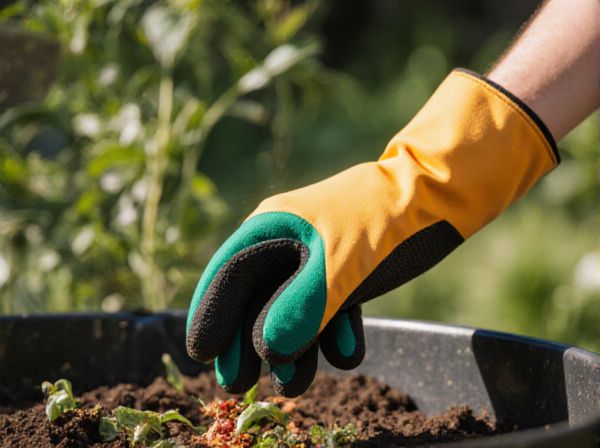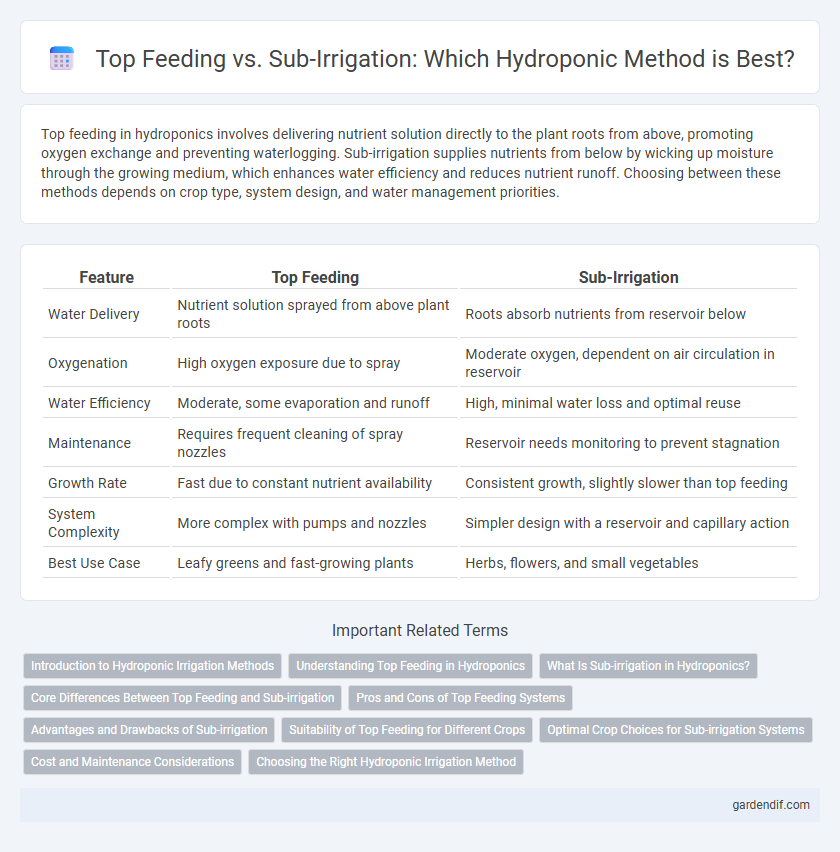
Top feeding vs Sub-irrigation Illustration
Top feeding in hydroponics involves delivering nutrient solution directly to the plant roots from above, promoting oxygen exchange and preventing waterlogging. Sub-irrigation supplies nutrients from below by wicking up moisture through the growing medium, which enhances water efficiency and reduces nutrient runoff. Choosing between these methods depends on crop type, system design, and water management priorities.
Table of Comparison
| Feature | Top Feeding | Sub-Irrigation |
|---|---|---|
| Water Delivery | Nutrient solution sprayed from above plant roots | Roots absorb nutrients from reservoir below |
| Oxygenation | High oxygen exposure due to spray | Moderate oxygen, dependent on air circulation in reservoir |
| Water Efficiency | Moderate, some evaporation and runoff | High, minimal water loss and optimal reuse |
| Maintenance | Requires frequent cleaning of spray nozzles | Reservoir needs monitoring to prevent stagnation |
| Growth Rate | Fast due to constant nutrient availability | Consistent growth, slightly slower than top feeding |
| System Complexity | More complex with pumps and nozzles | Simpler design with a reservoir and capillary action |
| Best Use Case | Leafy greens and fast-growing plants | Herbs, flowers, and small vegetables |
Introduction to Hydroponic Irrigation Methods
Top feeding hydroponic systems deliver nutrient solutions directly to plant roots from above, promoting oxygenation and preventing waterlogging. Sub-irrigation involves watering plants from below, allowing roots to absorb moisture through capillary action, enhancing water conservation and reducing disease risk. Both methods optimize nutrient uptake but differ in water efficiency and root aeration, crucial for maximizing hydroponic crop yields.
Understanding Top Feeding in Hydroponics
Top feeding in hydroponics involves delivering nutrient-rich water directly to the plant roots from above using drip emitters or spray nozzles, promoting targeted nutrient absorption and oxygenation. This method allows precise control over nutrient flow and prevents waterlogging by facilitating efficient drainage. Top feeding enhances root zone aeration, reducing the risk of diseases while supporting optimal growth conditions for various hydroponic crops.
What Is Sub-irrigation in Hydroponics?
Sub-irrigation in hydroponics is a method where water and nutrients are delivered directly to the plant roots from below, promoting efficient nutrient uptake and reducing water waste. This technique involves a reservoir system that allows plants to absorb moisture through capillary action, ensuring consistent hydration without oversaturation. Compared to top feeding, sub-irrigation enhances oxygen availability to roots, minimizes nutrient runoff, and supports sustainable indoor farming practices.
Core Differences Between Top Feeding and Sub-irrigation
Top feeding hydroponic systems deliver nutrient-rich water directly to the plant roots from above, promoting oxygenation and efficient nutrient absorption. Sub-irrigation systems supply water from below, allowing plants to uptake moisture through capillary action, which minimizes water waste and reduces root rot risk. The core difference lies in water delivery direction and oxygen availability, impacting plant growth rates and system maintenance requirements.
Pros and Cons of Top Feeding Systems
Top feeding systems in hydroponics offer precise nutrient delivery directly to the plant roots, promoting faster growth and reducing water wastage. However, this method requires regular monitoring to avoid overwatering and can lead to potential clogging of drip emitters. Maintenance demands and initial setup costs are typically higher compared to sub-irrigation systems, but top feeding excels in oxygenating the root zone effectively.
Advantages and Drawbacks of Sub-irrigation
Sub-irrigation systems provide efficient water use by delivering nutrients directly to plant roots, reducing evaporation and runoff compared to top feeding. These systems promote consistent moisture levels, enhancing root health and improving nutrient uptake. However, sub-irrigation can pose challenges such as potential salt buildup in the growing medium and difficulties in monitoring nutrient levels, requiring careful management to prevent root diseases.
Suitability of Top Feeding for Different Crops
Top feeding systems offer exceptional suitability for a wide range of leafy greens, herbs, and small-fruited crops due to precise nutrient delivery and enhanced oxygen availability at the root zone. Crops like lettuce, basil, and strawberries respond well to the top feeding method, which supports rapid growth and reduces risk of waterlogging. This method is less ideal for large, fruit-bearing plants like tomatoes and cucumbers that require stable, consistent moisture levels better provided by sub-irrigation.
Optimal Crop Choices for Sub-irrigation Systems
Sub-irrigation systems are ideal for water-efficient crops such as lettuce, spinach, and herbs, which have shallow root structures and benefit from consistent moisture levels. Root vegetables like radishes and carrots also thrive under sub-irrigation due to steady nutrient availability in the lower root zone. These systems optimize water use and nutrient delivery, enhancing growth rates and yields in suitable leafy greens and root crops.
Cost and Maintenance Considerations
Top feeding hydroponic systems generally incur higher initial costs due to complex pump and emitter setups, while sub-irrigation systems offer a cost-effective alternative with simpler wicking or capillary action mechanisms. Maintenance demands for top feeding include regular cleaning of pumps and emitters to prevent clogging, whereas sub-irrigation systems require less frequent intervention but careful monitoring of water levels to avoid root rot. Choosing between the two depends on balancing upfront investment with ongoing maintenance capability and budget constraints.
Choosing the Right Hydroponic Irrigation Method
Top feeding hydroponic systems deliver nutrient solution directly to the plant roots from above, ensuring oxygenation and preventing waterlogging, while sub-irrigation involves delivering water from below, promoting consistent moisture levels and reducing water waste. Choosing the right hydroponic irrigation method depends on plant type, growth stage, and system maintenance preferences, as top feeding suits fast-growing plants requiring frequent oxygen, and sub-irrigation is ideal for water-efficient cultivation of leafy greens. Optimal irrigation selection enhances nutrient uptake, improves plant health, and maximizes yields in hydroponic gardening.
Top feeding vs Sub-irrigation Infographic

 gardendif.com
gardendif.com